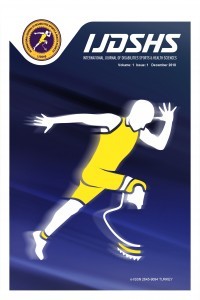Proximal to distal posture correction protocol for IT band friction syndrome in female amateur runners
Keywords:- Iliotibial band syndrome, IT band syndrome, ITBS, posture correction of lower limb, IT band treatment, Issues of female runners, amateur runners, running injury.
Proximal to distal posture correction protocol for IT band friction syndrome in female amateur runners
IT band syndrome, posture correction of lower limb, IT band treatment, Issues of female runners, amateur runners, running injury. Keywords:- Iliotibial band syndrome, IT band syndrome, ITBS, posture correction of lower limb, IT band treatment, Issues of female runners, amateur runners, running injury.,
___
- Balachandar, V., Hampton,M., Riaz, O. And Woods, S. (2019). Iliotibial Band Friction Syndrome: A Systematic Review and Meta-analysis to evaluate lower-limb biomechanics and conservative treatment. Muscle Ligaments and Tendons Journal;9 (2):181-193. DOI:10.32098/MLTJ.02.2019.05
- Barnier, I. & Viseux, F. (2019). Effect of postural insoles on iliotibial band syndrome in runners: a multicentre prospective study. Doi: 10.13140/RG.2.2.19325.92645.
- Beers, A., Ryan, M., Kasubuchi, Z., Fraser, S. and Taunton, JE. (2008). Effects of multi-modal physiotherapy, including hip abductor strengthening, in patients with iliotibial band friction syndrome. Physiother Can;60:180-188.. doi: https://doi.org/ 10.3138 /physio. 60.2.180
- Beynnon, D.B. and Shultz, J.S. (2008) Anatomic Alignment, Menstrual Cycle Phase, and The Risk of Anterior Cruciate Ligament Injury. Journal of Athletic Training; Vol. 43,No. 5,pp.541-542.doi: https://doi.org/10.4085/1062-6050-43.5.541
- Bhore, P. and Shinde, S. (2023). Effect of multi-component exercises program on pain-related gait adaptations among individuals with osteoarthritis of the knee joint. Journal of Education and Health Promotion; 1;12(1): 138. doi:10.4103/jehp.jehp_1628_22
- Bonaldi, VM., Chhem, RK., Drolet, R., Garcia, P., Gallix, B. and Sarazin, L.(1998). Iliotibial band friction syndrome: sonographic findings. J Ultrasound Med; Apr;17(4):257-60. doi: 10.7863/jum.1998.17.4.257. PMID: 9544609.
- Beals, C. and David Flanigan, D. (2013). "A Review of Treatments for Iliotibial Band Syndrome in the Athletic Population ", Journal of sports medicine; vol., Article ID 367169, 6 pages, .doi: https:// doi.org/ 10.1155/2013/367169
- de Araujo, MK., Baeza, RM., Zalada, SR., Alves, PB. and de Mattos CA.(2015). Injuries among amateur runners. Rev Bras Ortop; Sep 8;50(5):537-40. doi: 10.1016/j.rboe. 2015.08. 012. PMID: 26535199; PMCID: PMC 461 0991.
- Ferber, R., Noehren, B., Hamill, J. and Davis, IS. (2010). Competitive female runners with a history of iliotibial band syndrome demonstrate atypical hip and knee kinematics. J Orthop Sports Phys Ther; Feb;40(2):52-8. doi: 10.2519/jospt.2010. 3028. PMID: 20118523.
- Francis, P., Whatman, C., Sheerin, K., Hume, P. and Johnson, MI. (2019). The Proportion of Lower Limb Running Injuries by Gender, Anatomical Location and Specific Pathology: A Systematic Review. J Sports Sci Med; 11;18(1):21-31. PMID: 30787648; PMCID: PMC6370968.
- Fredericson, M. and Wolf, C. (2005). Iliotibial band syndrome in runners: innovations in treatment. Sports Medicine; 35: 451-9. doi:https:// doi.org/10.1016/j.pmr.2015. 08. 0 01 Friede, MC., Innerhofer, G., Fink, C., Alegre, LM. and Csapo, R. (2021). Conservative treatment of iliotibial band syndrome in runners: Are we targeting the right goals?. Physical Therapy in Sport;Dec 27. doi:https://doi.org/10.1016/j.ptsp.2021.12.006
- Gerçek, H., Işık, İ.D., Gürel, M.N., Özünlü Pekyavaş, N. and Altıntaş, A. (2023). Comparison of Sports Injury Anxiety in Athletes Doing Sports on Different Surfaces. Int J Disabil Sports Health Sci;5(2):1-7.https://doi.org/10.33438/ijdshs.1194 307
- Hewett, T.E., Myer, G.D., Ford, K.R. (2005) Biomechanical Measures of Neuromuscular Control and Valgus Loading of the Knee Predict Anterior Cruciate Ligament Injury Risk in Female Athletes: A Prospective Study. The American Journal of Sports Medicine: 2005, Vol. 33, No. 4, pp492501. doi:https://doi.org/10.1177/ 036354 65042 6959
- IAAF Competition Rules for Road Races”. International Association of Athletics Federations. 2009. Archived from the original on 23 September 2015. Retrieved 1 November 2010. doi: http://hdl.handle.net/ 11394/6250
- Kolhatkar, AS. and Shinde, SB. (2020). Effectiveness of a Conditioning Program on Amateur Female Marathon Runners. Journal of Evolution of Medical and Dental Sciences; Jul 20;9(29):2040-5. doi: 10.14260/jemds /2020/444
- McKay, J., Maffulli, N., Aicale, R. and Taunton, J. (2020). Iliotibial band syndrome rehabilitation in female runners: a pilot randomized study. Journal of orthopaedic surgery and research; Dec;15(1):1-8. doi:: 10.1186/s13018-020-01713-7
- Nurfadhilah, MI. and Yudhistira, JF. (2023). Correlation between Leg Length Discrepancies (LLD) with ITB Syndrome: A Systematic Review. Orthopaedic Journal of Sports Medicine; Jan 31;11(2_suppl):232 5967121S00865.
- Sawant Janhavi, M. and Shinde, S. (2021). Effect of lower limb proximal to distal muscle imbalance correction on functional pes planus deformity in young adults”. Journal of medical pharmaceutical and allied sciences; 10(4) 3469-3473. doi: 10.22270/jmpas. V10 I4.1477
- Schreiber, R. and Louw, Q. (2011). The effect of gluteus medius training on hip kinematics in a runner with iliotibial band syndrome. South African Journal of Physiotherapy;Jan 5;67(2):23-8.DOI: https://doi.org/10.4102/ sajp.v67i2.42
- Shamus, J. and Shamus, E. (2015). The management of iliotibial band syndrome with a multifaceted approach: a double case report. Int J Sports Phys Ther; Jun;10(3): 378-90. PMID: 26075154; PMCID: PMC 4458926.
- Ünüvar, B.S. and Demirdel, E. (2022). The Relationship of Ober Tilt Angle with Pressure Pain Threshold and Hip Abductor Muscle Strength in Athletes with Iliotibial Band Tension. Süleyman Demirel University Journal of Health Sciences. 2022; 13(1):92-99. doi:https://doi.org/10.22312/sdusbed.949307
- van der Worp, MP., van der Horst, N., de Wijer, A., Backx, FJ. and Nijhuis-van der Sanden, MW. (2012). Iliotibial band syndrome in runners: a systematic review. Sports Med; Nov 1;42(11):969-92. doi: 10.2165/11635400-000000000-00000.PMID: 22994651.
- Yayın Aralığı: Yılda 3 Sayı
- Başlangıç: 2018
- Yayıncı: Nevzat DEMİRCİ
Ramil AHMADOV, Nazlı DEMİR, Merve KURT, Tülay TARSUSLU
Nayan KADAV, Radha BHENDE, Sandeep SHİNDE
Tezel YILDIRIM ŞAHAN, Duygu TÜRKER, Büşra Nur AKSU, Melike ÖZCAN, Elif YAVAŞ, Seda BİCİCİ ULUŞAHİN
Diajeng Tyas Pinru PHYTANZA, Erick BURHAEIN, Carla Cristina Vieira LOURENÇO, Ratko PAVLOVIC
Sebelasmaret Boccia Throw Test (SBTT) Instrument Development
Satria Yudi GONTARA, Rumi DOEWES
Determination of Anthropometric Measurements and Nutritional Status of Wheelchair Basketball Players
Ayşe Hümeyra İSLAMOĞLU, Esra ÖNDAR, Tuğçe YILDIRIM, Zehra KARTAL
Berivan Beril KILIÇ, Hakan AKGÜL, Eren TİMURTAŞ, Aysel YILDIZ ÖZER
Halil İbrahim BULGUROĞLU, Merve BULGUROĞLU, Cansu GEVREK, Serenay ZORLU, Sezen DİNCER, Kübra KENDAL
Does Function Level of Individuals With Autism Spectrum Disorder Affect The Family Impact?
